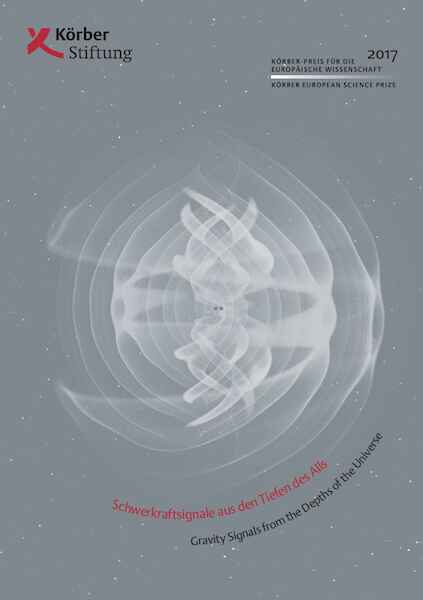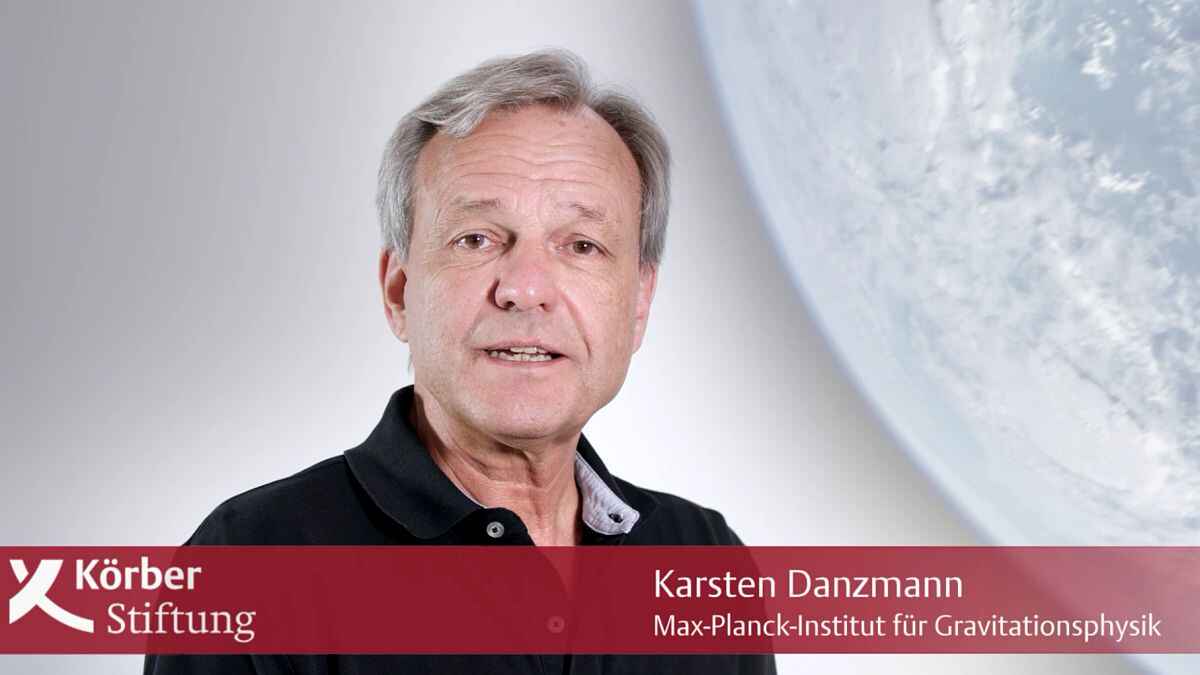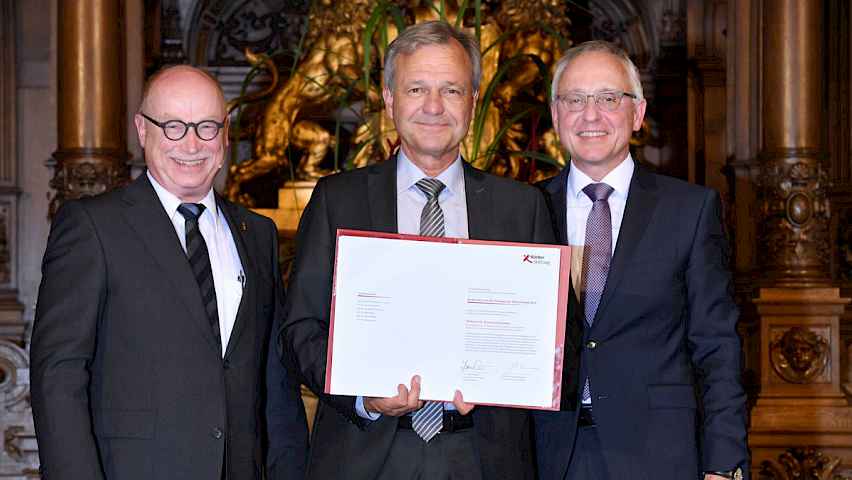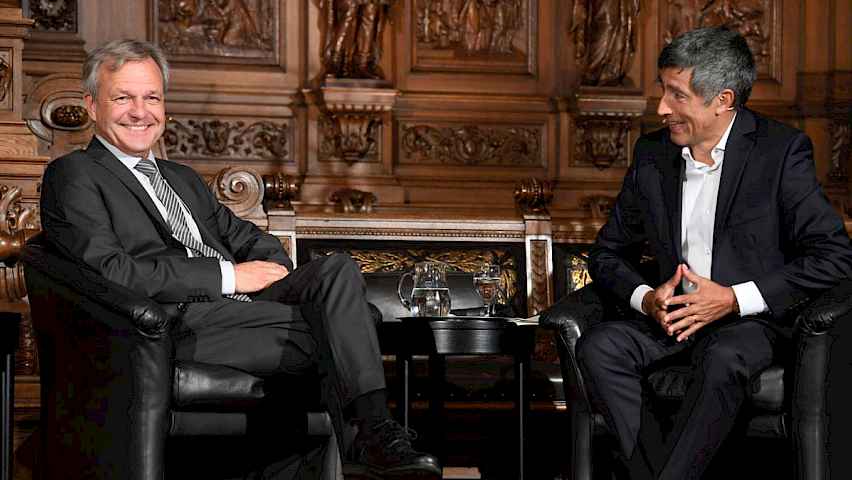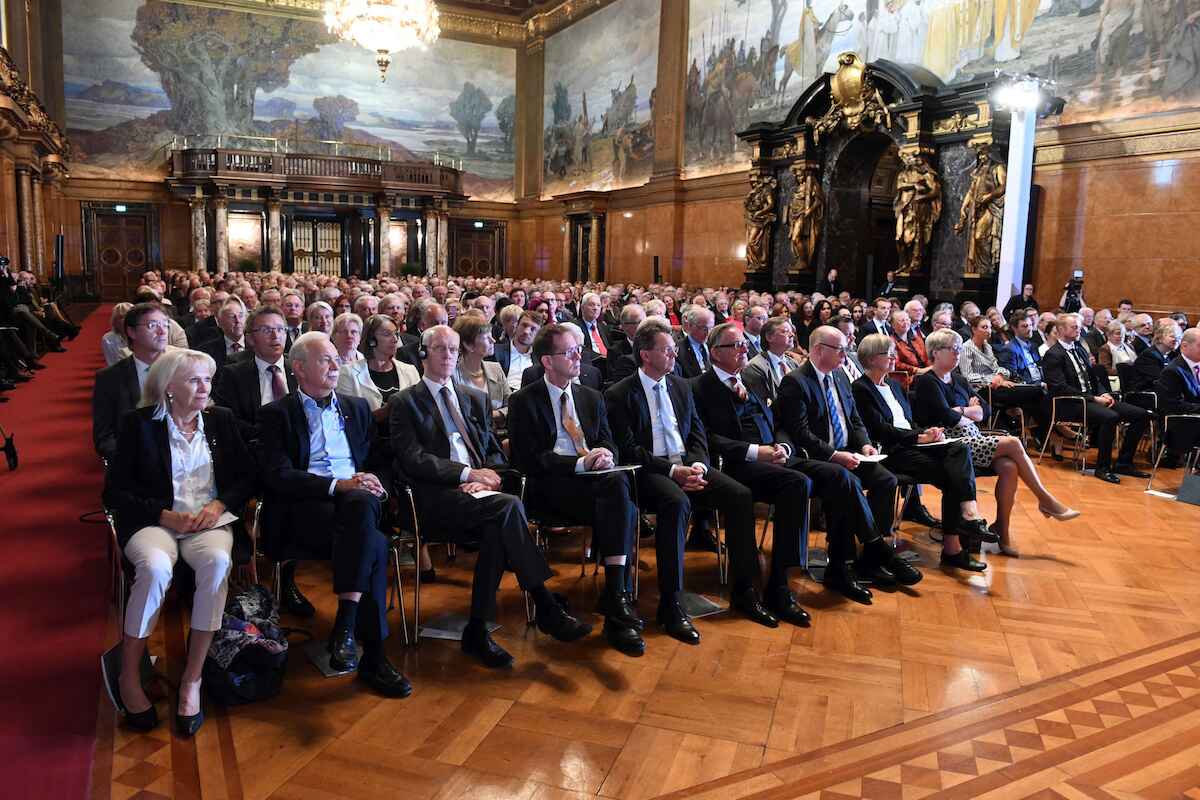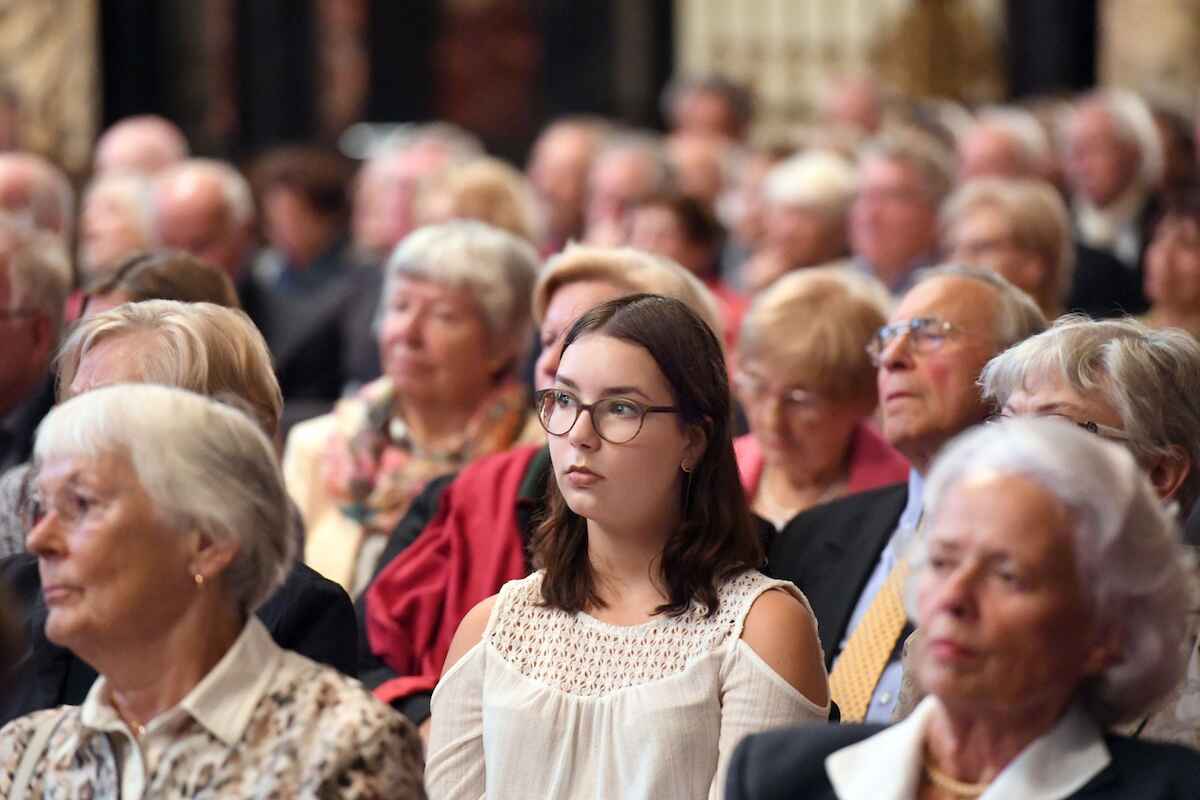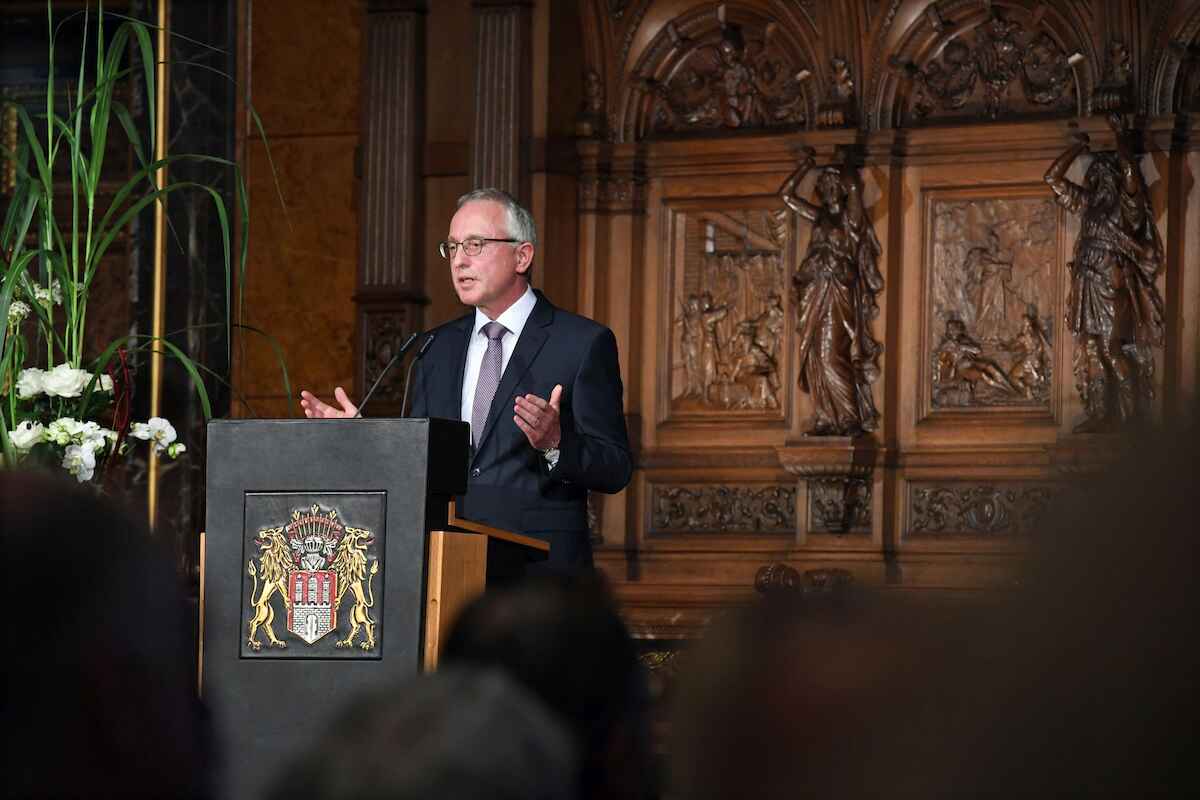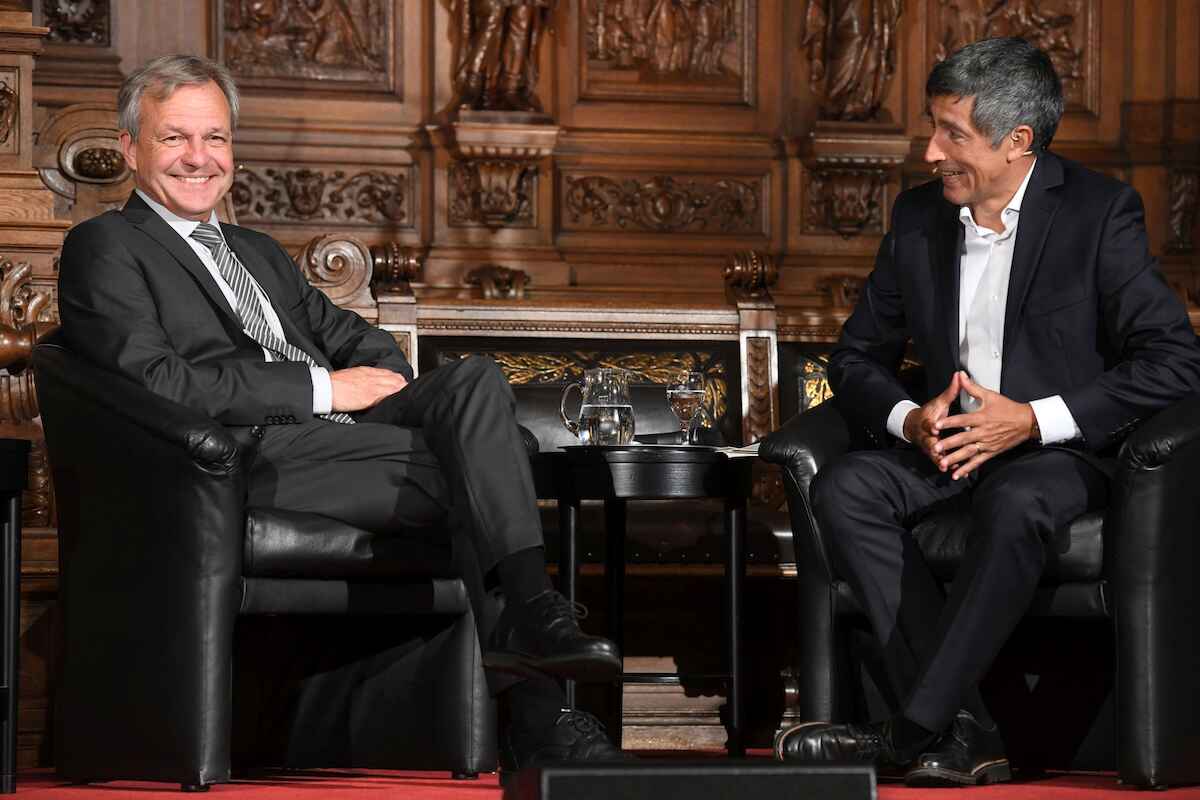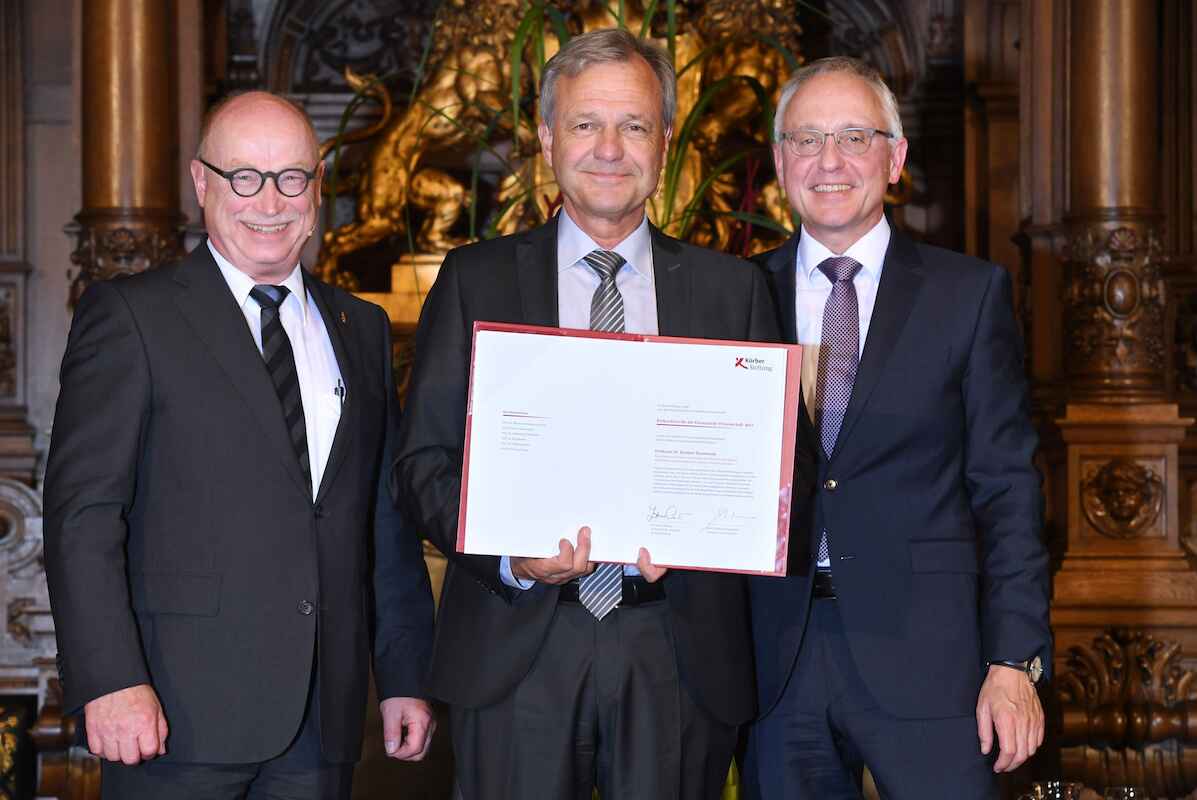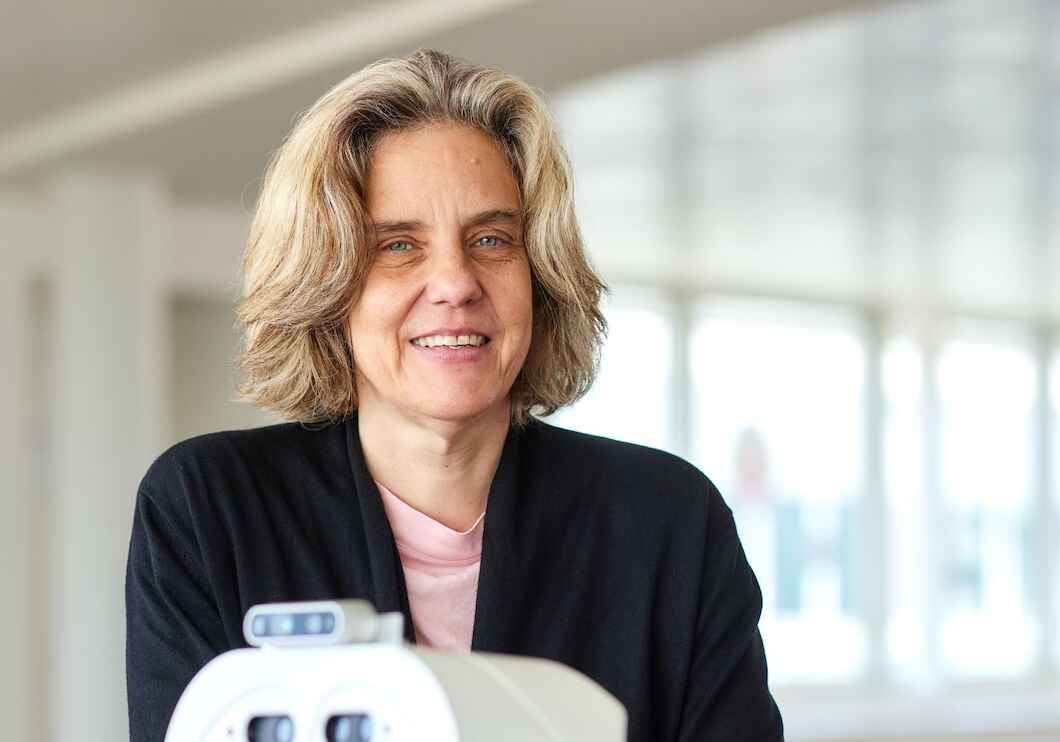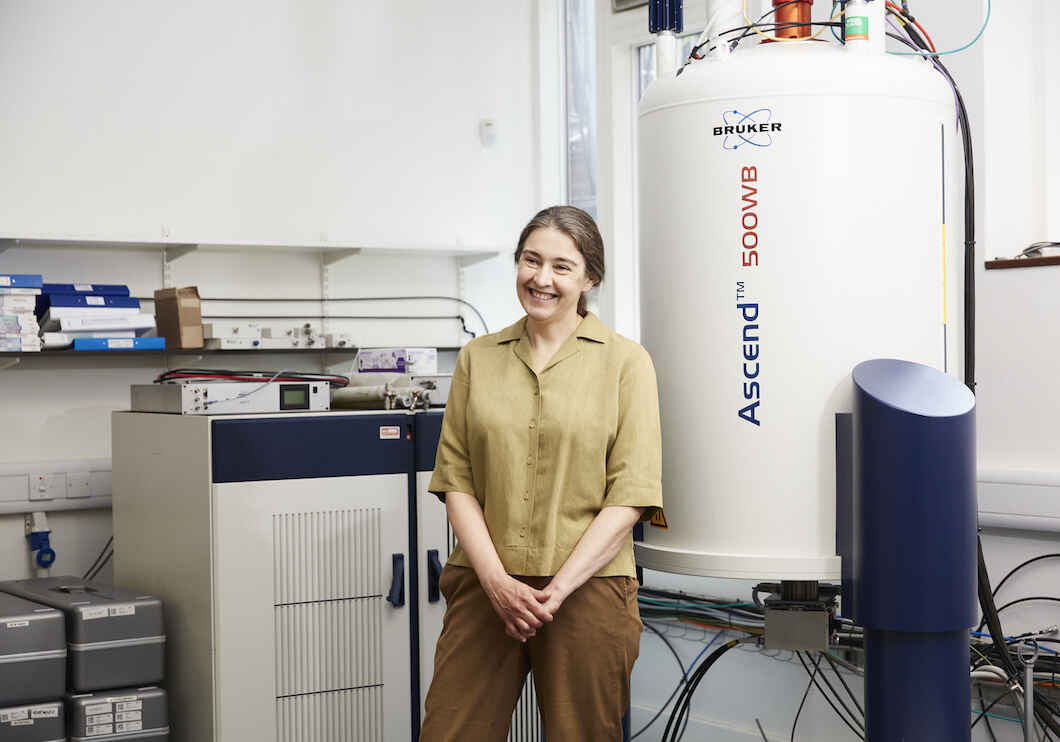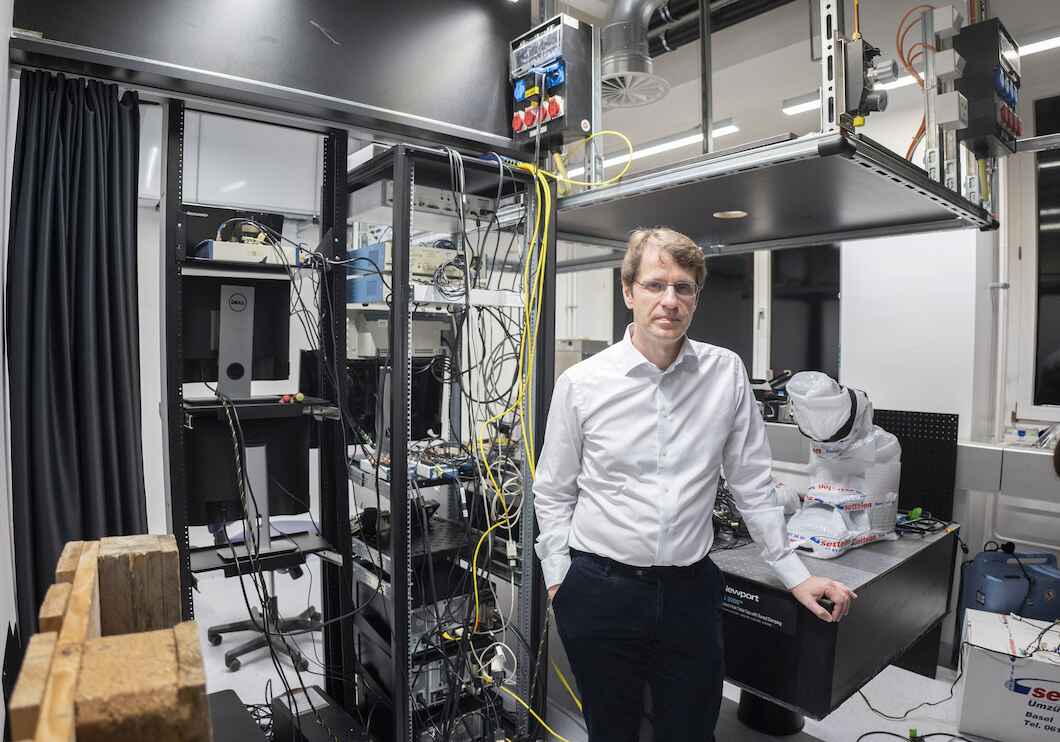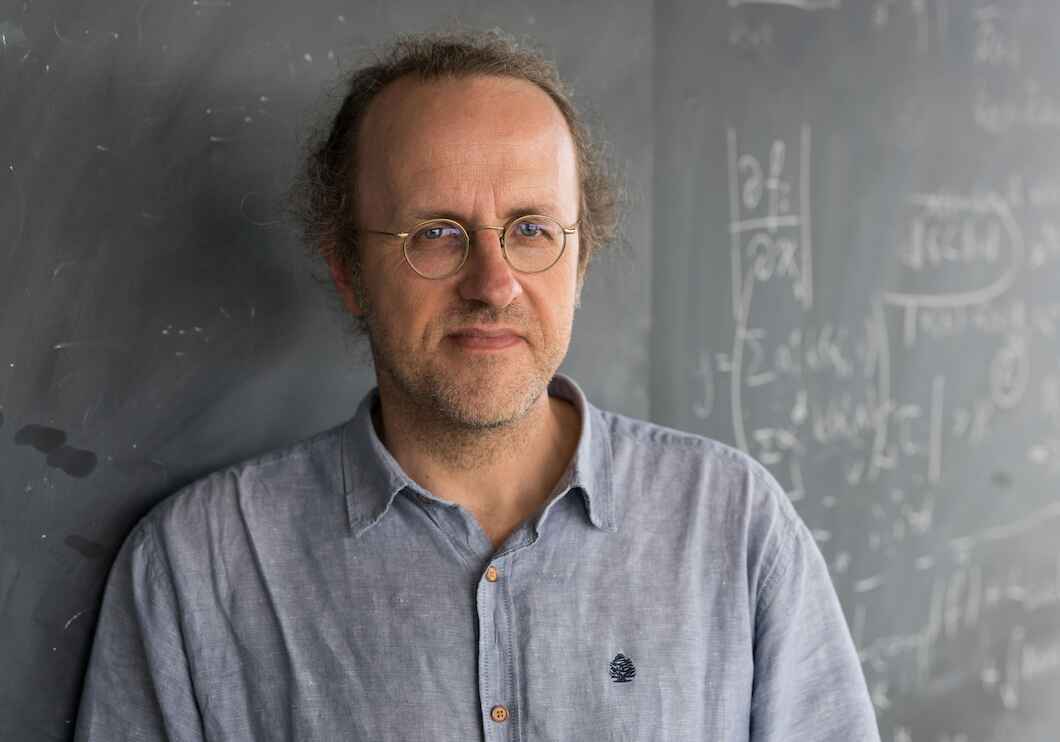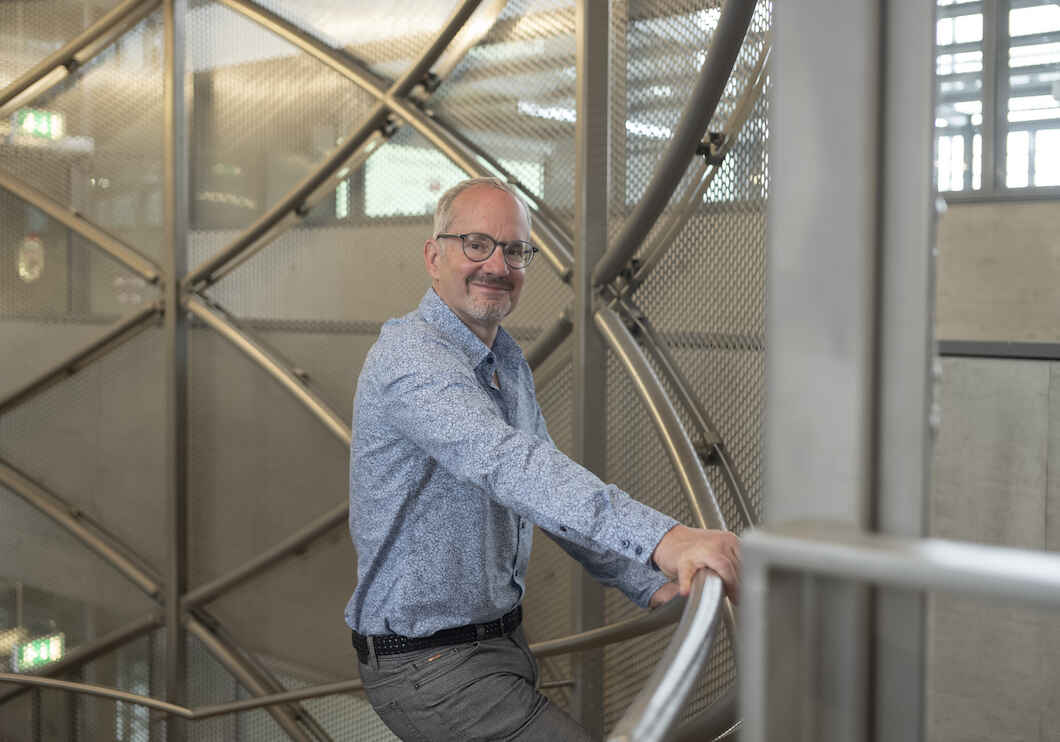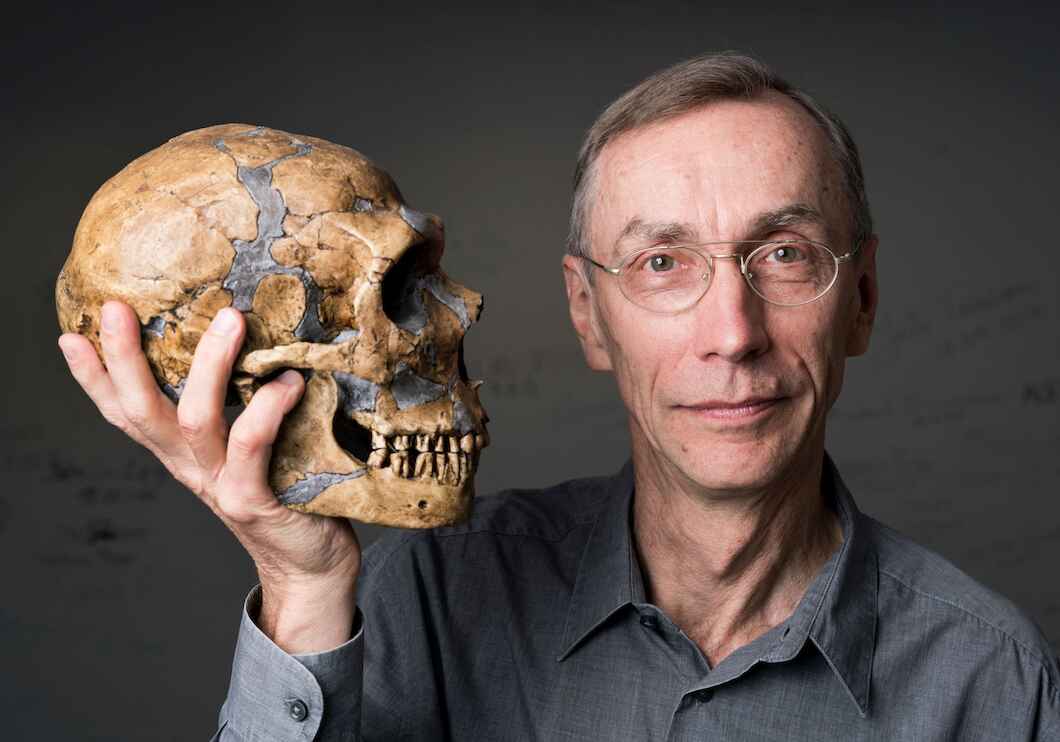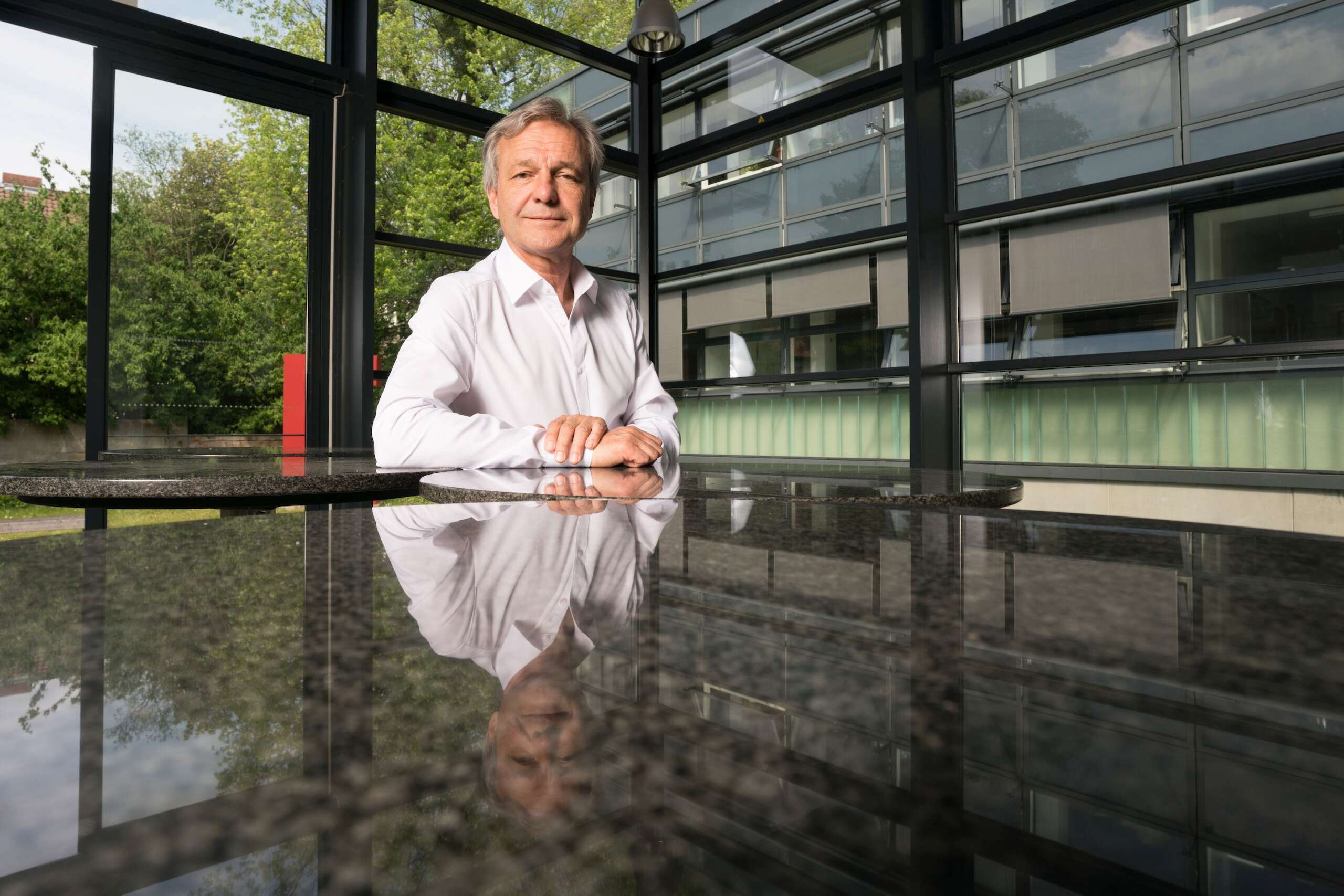
Karsten Danzmann (2017):
Signals of Gravity from the Depths of Space
The German physicist Karsten Danzmann and his German-British team developed the key technologies used by the LIGO detectors in America to detect gravitational waves directly for the first time on September 14, 2015. Such a “vibration of space-time”, as triggered by massive collisions or explosions in space, had been predicted theoretically by Albert Einstein a century earlier. This sensational discovery signifies that researchers had opened a new window onto space. Gravitational wave astronomy makes it possible for them to use these signals of gravity to study the dark side of the cosmos.
Signals of Gravity from the Depths of Space
Text: Claus-Peter Sesín
Photos: Friedrun Reinhold
The first human to have ever seen the signal of a gravitational wave is Marco Drago, an Italian postdoc. On September 14, 2015, he was sitting in front of his computer at the Max Planck Institute (MPI) for Gravitational Physics in Hannover and analyzing the streams of data being received from the LIGO detectors (at the Laser Interferometer Gravitational Wave Observatory) in America. The two identical stations there are specialized for measuring gravitational waves. At 11:50 a.m. the LIGO sensors reported that they had detected a signal in the raw data. The American colleagues were not in a position to notice the signal since it was night there and they were asleep.
Drago immediately informed his MPI colleagues. The signal was surprisingly so strong and clear that it was visible in the raw data with an unaided eye. It appeared almost too good to be true. Had the colleagues in the USA perhaps fed a test signal to the stations and forgotten to inform the community? Moreover, at the time both of the LIGO detectors were still in the test phase and nobody had anticipated a successful measurement.
Yet after three months of intensive evaluation, the LIGO Scientific Collaboration (LSC) – a team of over a thousand researchers from 18 countries – was able to eliminate any doubts. In the southern hemisphere, 1.3 billion light years from the Earth, a pair of giant black holes that had been orbiting one another collapsed together. The mass of one of them was 29 times that of the sun, and that of the other was 36 times the size. Upon their merger, an even heavier black hole weighing 62 solar masses was created. The difference of three solar masses was the energy emitted during this cosmic mega event in the form of gravitational waves. In the final tenth of a second of the fusion, this energy was fifty times stronger than the light energy produced by all of the stars in the universe during the same time.

Already on December 26, 2015, the LIGO detectors recorded the next merger. This time two smaller black holes merged that were 1.4 billion light years away. The solar masses of these two black holes were 8 and 14; they created a new giant of 21 solar masses. The team cheered since this removed any remaining doubts that the first measurement might have been an artifact. The third (and so far last) confirmation took place on January 4,2016. This time the LIGO detectors overheard the “death dances” of two black holes of 19 and 31 solar masses at a distance of 2.9 billion light years.
All of these precision measurements would not have been possible without the groundwork done by the team of researchers working with Karsten Danzmann. It developed many of the key technologies employed in the LIGO detectors, including the highly precise and stable laser systems as well as the optical systems that have sophisticated mechanisms protecting them against interference.
Karsten Danzmann, born in 1955, is one the world’s leading experts in the field of gravitational physics. After studying physics and receiving his doctorate in Hannover, he went to Stanford University in the USA, where he served as a professor of physics until 1989. From 1993 until 2001 he headed the Hannover branch of the MPI of Quantum Optics. Danzmann has been Director of the MPI for Gravitational Physics since 2002. Parallel to this, he has also been a professor of physics at the Leibniz Universität Hannover since 1993, where he also heads the Institute for Gravitational Physics.
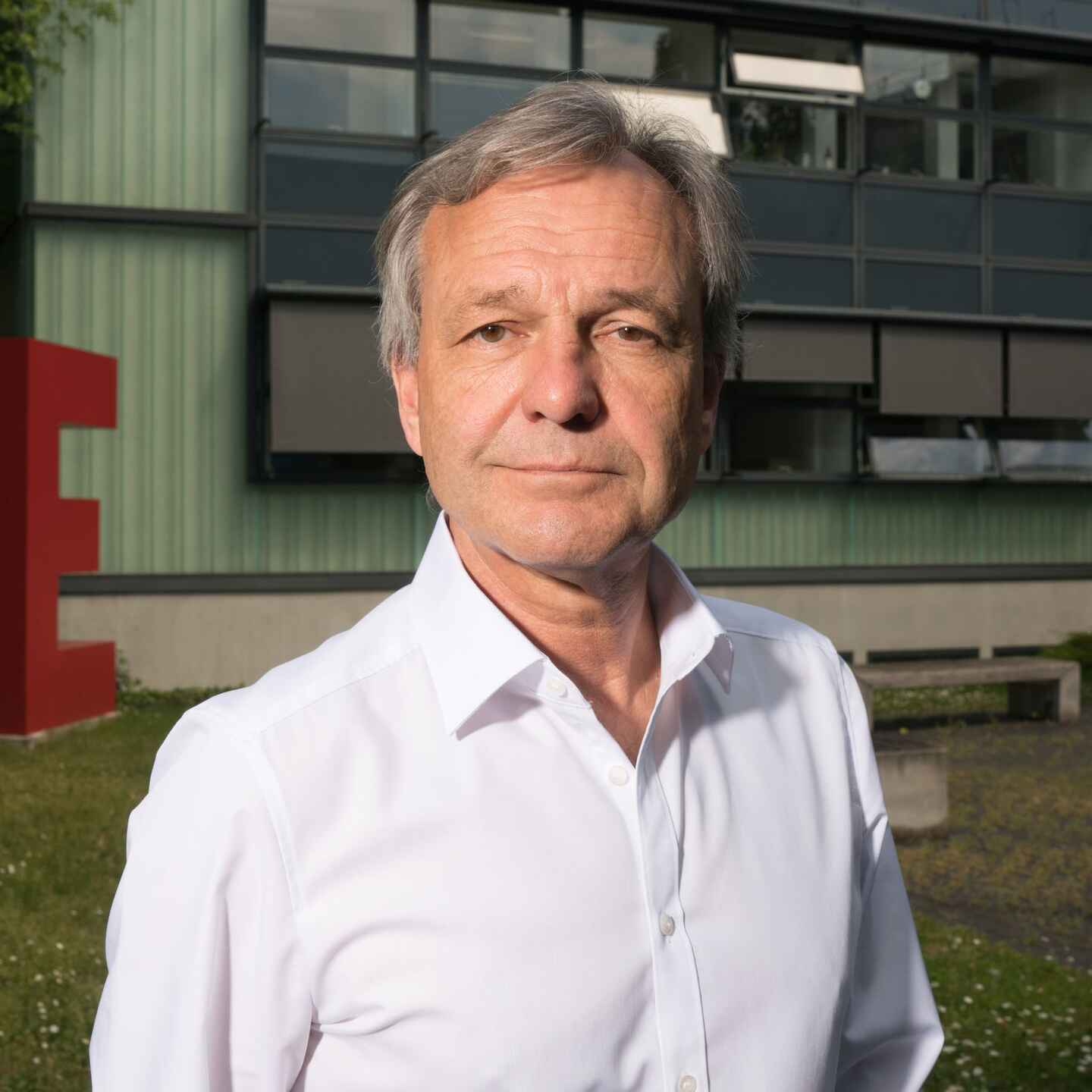
“For that reason alone, gravitational wave research holds the promise of many fundamentally new discoveries because 99 percent of the universe is dark and we have hardly been able to study it.”
Karsten Danzmann
Astronomers, in particular, are pleased that gravitational waves can now be precisely measured. “It is as if human ity had been given a new sensory organ”, comments Sabine Hossenfelder, a physicist in Frankfurt. In gravitational wave astronomy, the researchers have literally opened a new window on the cosmos. Until now, they could only study space with the aid of electromagnetic waves, such as light, radio waves, and x-ray or gamma radiation. “Now gravity has sent us its own messenger, as it were”, Danzmann says. “For that reason alone, gravitational wave research holds the promise of many fundamentally new discoveries because 99 percent of the universe is dark and we have hardly been able to study it”.
Albert Einstein proved the existence of gravitational waves already in 1916, deriving it mathematically from the general theory of relativity that he formulated in 1915. By publishing his general and special theories of relativity – the latter already in 1905 – Einstein turned the world of physics up-side down, particularly Isaac Newton’s classical mechanics. Newton considered the mass of a body to be a constant. Einstein, however, demonstrated that the mass of a body increases greatly if it is accelerated to a speed close to that of light. The speed of light is thus a natural speed limit throughout the entire universe, even for the spread of energy and information.
According to the theory of relativity, gravity originates by the fact that a mass bends the four-dimensional space-time that Einstein postulated. Simplified, this can be envisaged as a tightly stretched rubber mat. If a heavy ball is placed on it, the mat buckles downwards – space-time bends. If a smaller ball then passes nearby, its path is deflected by the dent made by the heavy ball. This path deviation is the consequence of gravity in space-time.
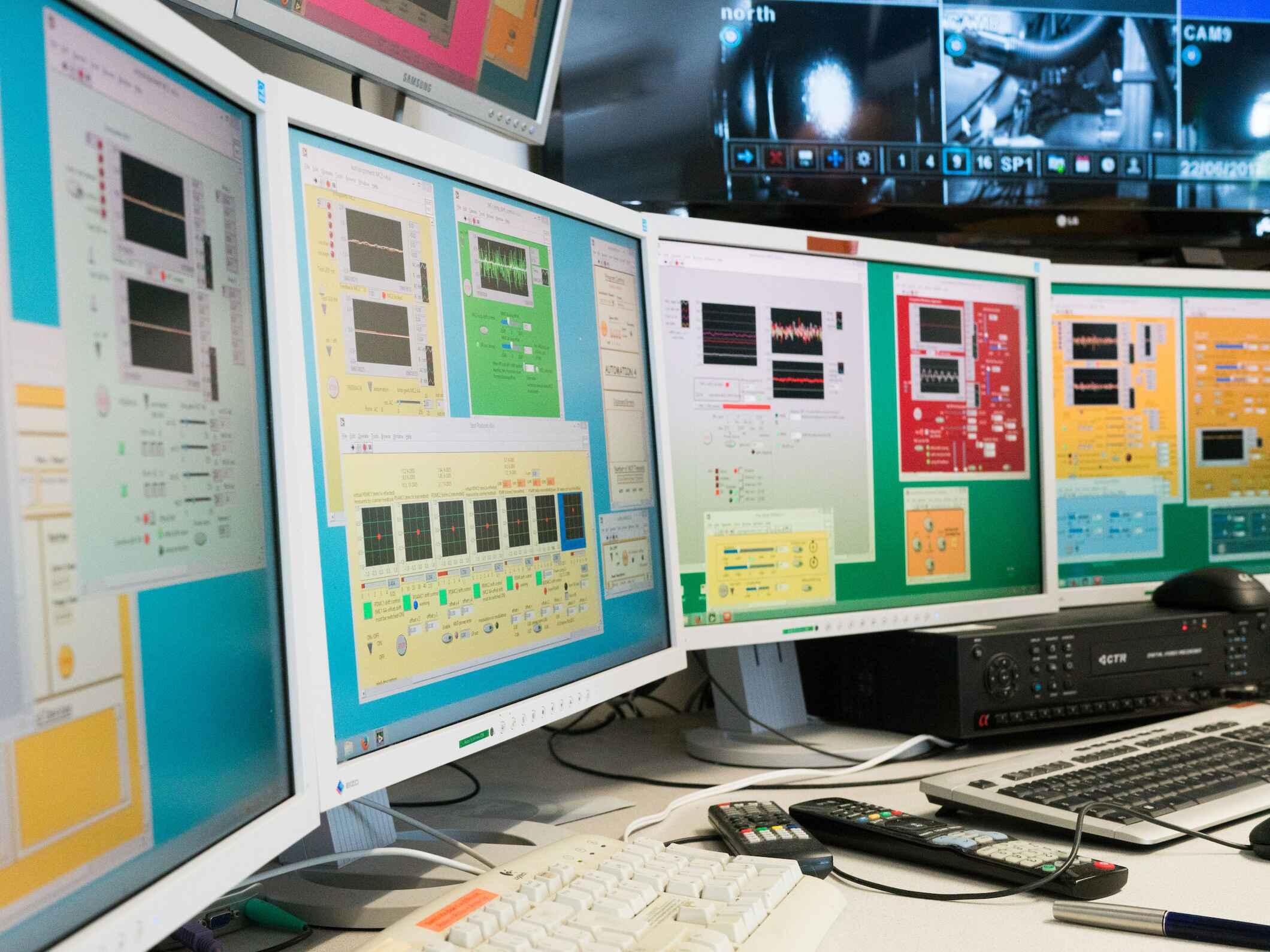
If a particularly heavy ball is thrown very forcefully at the mat, the entire surface of the mat shakes. These vibrations correspond to Einstein’s gravitational waves, which spread as cosmic quakes through space-time at the speed of light. This disproves Newton’s thesis that the effect of gravity is immediate throughout all of space without any delay.
Since gravitational waves only bend space-time a minimal amount, Einstein believed they could never be detected. These waves are typically triggered by cosmic catastrophes such as the explosion of a supernova or the fusion of two black holes orbiting each other.
Gravitational waves pass through all matter. If they were to pass through an exercise ball, it would first become egg-shaped and stand on its tapered end, only to change to a flattened pumpkin – of course, imperceptibly minimal changes. Gravitational waves can be detected directly using Michelson interferometers, such as the two LIGO detectors. These interferometers are equipped with two very long measuring arms extending at right angles to each other. The basic principle is simple. If a gravitational wave passes through the detector, one of the arms is compressed and the other is stretched. These changes in length are measured using lasers. The measuring technique is highly complicated since it must be extremely precise. The four kilometer long measuring arms of the LIGO detectors change in length by only a few thousandths of the diameter of the nucleus of a hydrogen atom.
The enormous measurement precision of the LIGO laser interferometer is the main achievement of Danzmann’s German-British team. Over one hundred scientists take part in the GEO Collaboration. These scientists operate their own detector, called GEO600, located near the village of Ruthe about 20 kilometers south of Hannover. The arms of this detector are only 600 meters long. In decades of detail work in GEO600 and smaller forerunner projects, the team has optimized the lasers and other measuring instruments in the detector to the highest degree of precision. For example, the optical systems are suspended as pendulums using highly stable silica fibers in order to absorb vibrations such as from an earthquake or automobiles. Hundreds of tiny actuators additionally diminish the impact of external vibrations. There is a high vacuum in the 600 meter long tubes of the measuring arms so that air molecules do not disturb the laser beam. To amplify the optical signals, both the laser beam and the measured signals are recycled in the system. This has further increased the measuring sensitivity tenfold. All of these achievements have been incorporated in the two American LIGO detectors. The laser systems of those detectors were designed, constructed, and even installed by the GEO600 scientists.
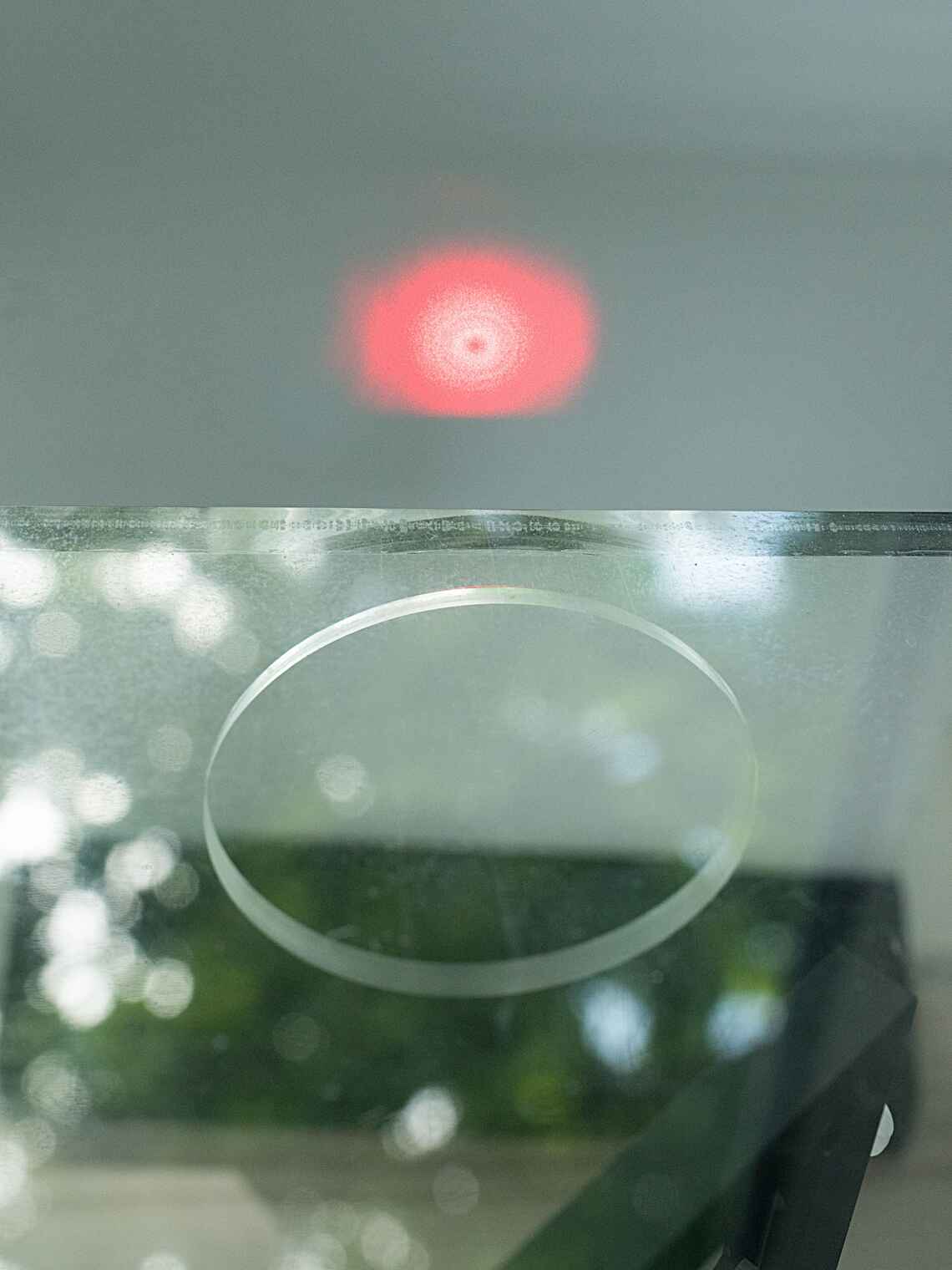
The principle behind a Michelson interferometer is based on interference. If two waves of the same or similar frequency (period of oscillation) are superimposed, they can either amplify or cancel one another depending on their phase. If two wave crests coincide, they combine to form a strong signal. If the wave crest of one wave is superimposed on the trough of another, then the two waves can cancel each other completely.
In a Michelson interferometer the beam of a powerful infrared laser is sent through a beam splitter and divided into two parts. The first goes through the first measuring arm and is reflected by a mirror at its end, while the second goes through the second arm and is also reflected by a mirror at the end. The two reflected parts meet again at a beam splitter and are redirected by it to a sensor.
The two parts of the beam are set so that they normally cancel one another through interference. In this case, no light reaches the sensor. This changes as soon as a gravitational wave passes through the arms. The wave compresses and stretches the arms’ lengths, meaning that one laser beam must pass through a longer path and the other a shorter one. As a consequence, the two reflected beams do not cancel each other at the beam splitter as a result of interference. The sensor then registers laser light that vibrates in the same tact, as it were, as the gravitational wave.
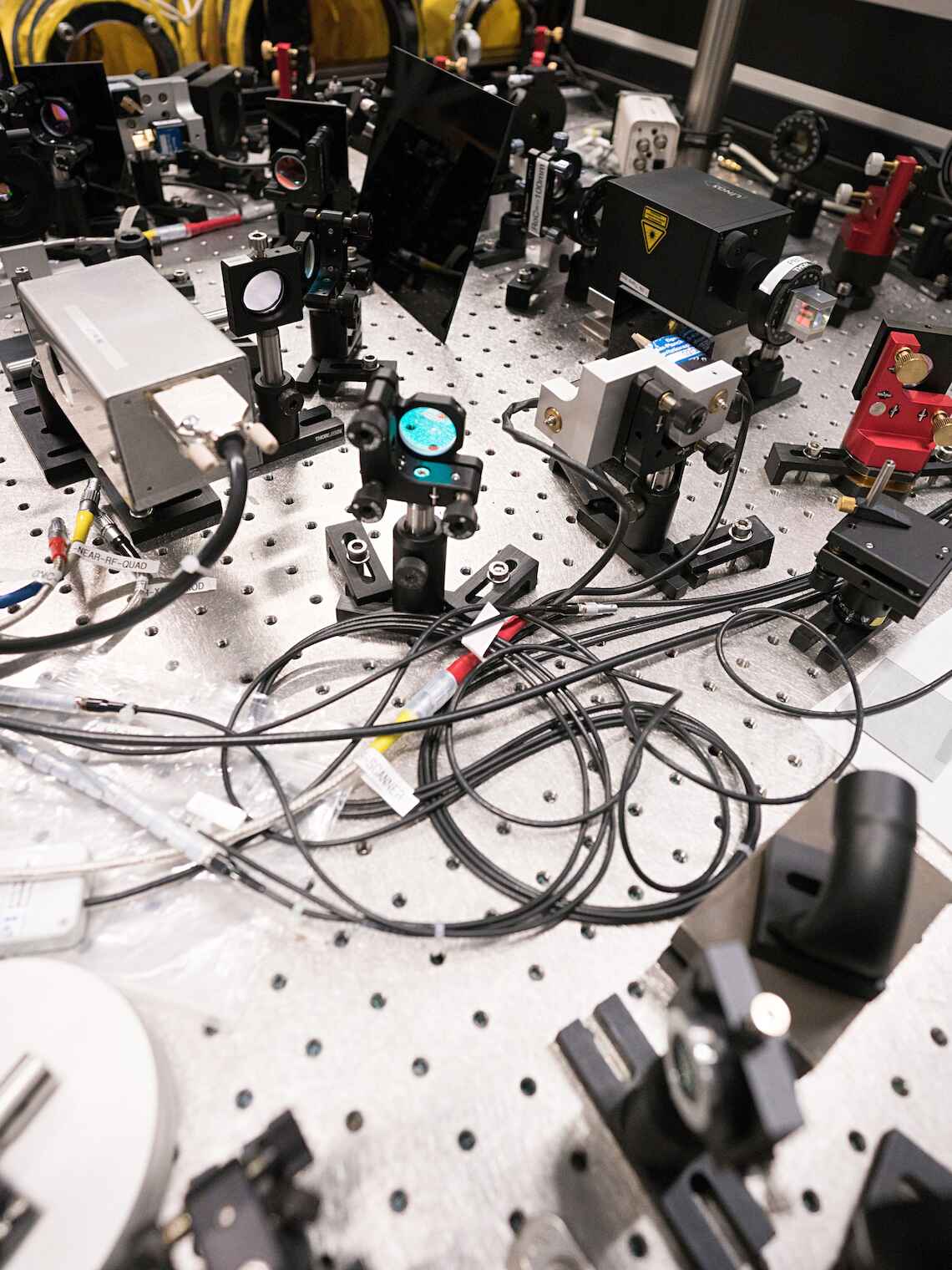
Gravitational waves always arise when masses are accelerated. Even when we raise our hand or a sprinter starts running, a tiny gravitational wave is created, which in practice, though, cannot be verified. Circular movements are also accelerated movements. For example, the Earth is constantly sending gravitational waves while it is orbiting the sun – although only in a strength corresponding to 200 watts, hardly enough to toast a slice of bread.
Really strong gravitational waves only result from violent cosmic events such as the explosion of a star. Larger stars, i.e., those of at least eight solar masses, collapse at the end of their lifetime under their own gravity. From a distance, this appears as the explosion of a supernova. For a brief time, supernovae can shine as brightly as a billion stars, making it possible for us to see them unaided during the day. Chinese scholars sighted one such blazing point of light that suddenly appeared in the sky in 1054.
In such an explosion, a supernova hurls its outer layer into space, out of the fragments of which strong radiation creates rare and heavy chemical elements such as gold. The core of the supernova, in contrast, collapses since there is nothing to withstand the gravity. The force of this implosion is so strong that the freshly baked atoms in the core are broken into their components. The consequence is that within a fraction of a second the core collapses to a sphere a few tens of kilometers in diameter. A neutron star is born. This relatively small sphere corresponding to the size of the Hamburg metropolitan area can nonetheless have a mass of multiple solar masses since it consists of densely packed neutrons as if it were a giant meganeutron.

“The four kilometer long measuring arms of the two LIGO detectors are custom made to eavesdrop on the fusion of mediumsized black holes.”
Karsten Danzmann
The product of the final explosion of an extremely massive star of more than 40 solar masses is a black hole. Its gravitation is so strong that not even particles of light can escape its field of gravity (thus its name). Even neutron stars can subsequently be transformed into black holes if they take up sufficient additional matter or if two of them collapse onto one another.
Danzmann and his colleagues want to use different types of Michelson interferometers in order to capture the gravitational waves that all of these cosmic mega events emit. The frequencies of these vibrations of space-time vary widely. They range from 0.0001 to 1000 hertz. “As a basic principle, the heavier the merging masses, the stronger the gravitational waves they emit and the lower their frequency”, according to Danzmann. The arm length of the Michelson detectors determines the frequency range that they are particularly sensitive for, similar to how in earlier portable radios the antenna length was designed to be optimal for the radio signal to be received.
The four kilometer long arms of each of the LIGO detectors are custom made, as it were, to eavesdrop on the gravitational waves that result from the merging of medium-sized black holes, such as the event first detected on September 14, 2015. The measuring signal that was recorded was therefore strong and, from a scientist’s point of view, beautiful.
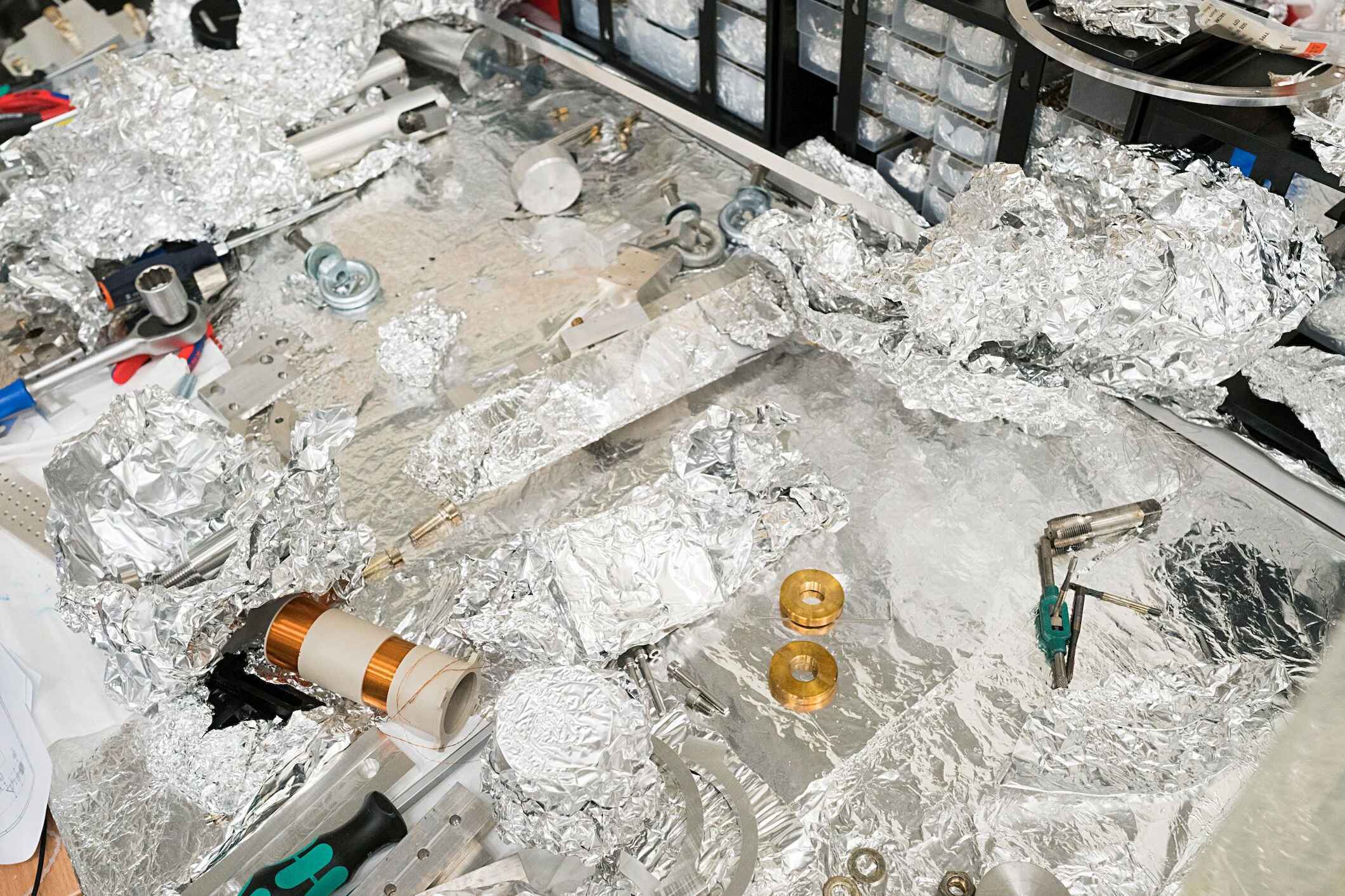
“The propagation of gravitational waves corresponds approximately to that of sound”, according to Danzmann. “Sound compresses and stretches air, and gravitational waves do the same with space”. To illustrate this you can make gravitational waves audible by using sound waves of the corresponding frequency.
The signal from GW150914 was typical. In the last second before the merger, as the two cosmic gluttons moved closer together, it resembled a sine curve whose zero crossings were pushed closer and closer together while the amplitude increased. At the same time, the frequency of the gravitational waves increased from 35 hertz (in sound waves, a deep bass tone) to 250 hertz (a high bass tone). The respective sounds for the merger of two smaller black holes or two neutron stars are much higher. Danzmann notes, “That can sound like a cricket. English-speaking scientists therefore also refer to the noise as a chirp”.
The arm length of the GEO600 detector located near Hannover is 600 meters, suitable for the “soprano” region of the gravitational wave spectrum. The maximum sensitivity of this detector is in the region of 1000 hertz. This corresponds, in sound waves, to a medium-high bleep. Two sources of gravitational waves in the 1000 hertz region are exploding supernovae and the merging of two smaller neutron stars. Thus GEO600 lacks the ears suitable for listening to the bass-heavy sounds of GW150914. In a purely metrological sense, GEO600 can hardly register signals in the region from 35 to 250 hertz such as those that flowed through the Earth on September 14, 2015.
Particularly slow and powerful vibrations of space-time are produced by the collision of two ultramassive black holes of over a million solar masses apiece, such as those that sit at the center of galaxies. Such a monster vibration oscillates at only 0.001 to 0.0001 hertz. This means that the gravitational wave needs between 17 minutes and almost three hours to complete a single oscillation. Such slow-motion vibrations cannot be made audible. Humans can only perceive tones between 20 and 20,000 hertz.
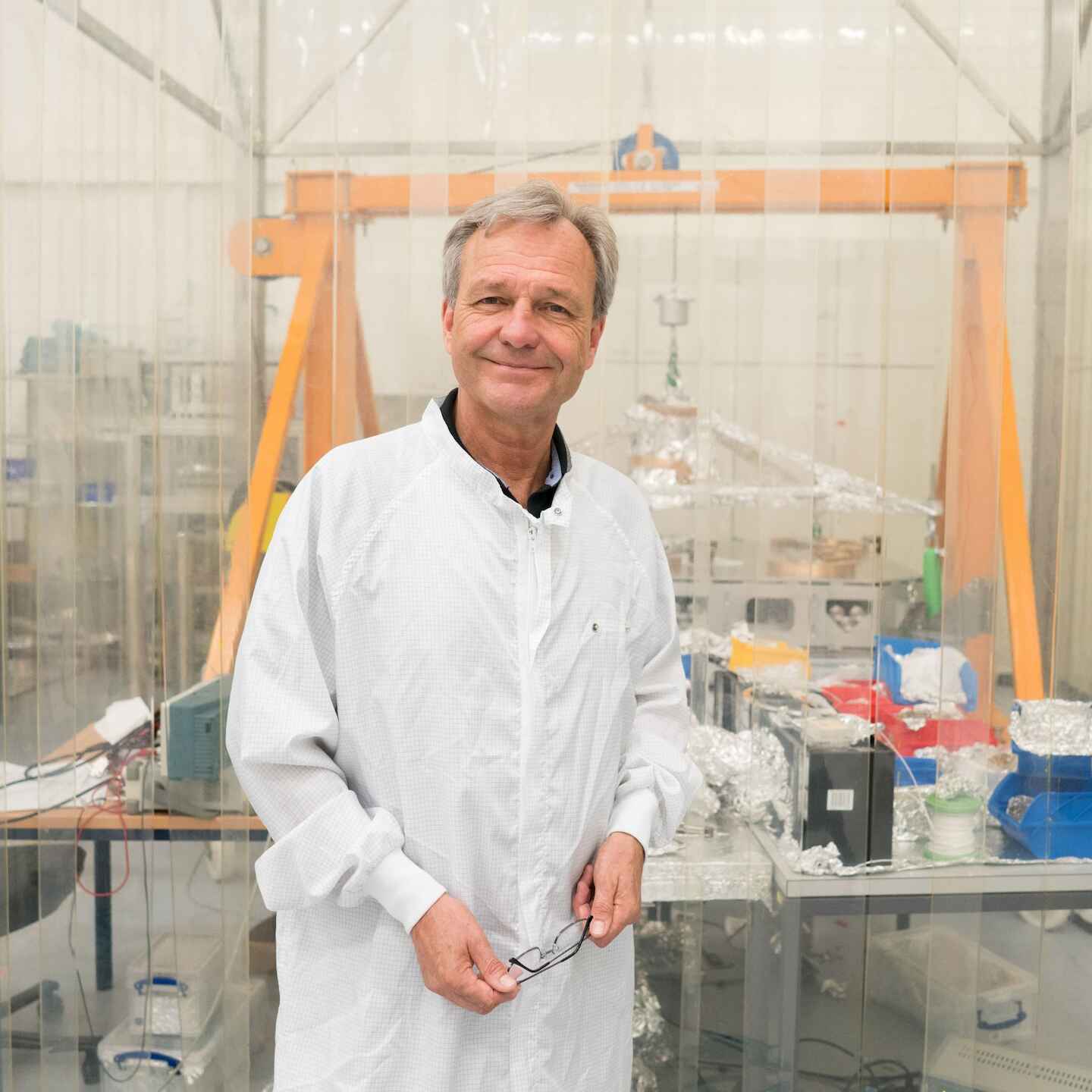
“The propagation of gravitational waves corresponds approximately to that of sound´, according to Danzmann. `Sound compresses and stretches air, and gravitational waves do the same with space.”
Karsten Danzmann
In order to be able to register very slowly oscillating gravitational waves, astrophysicists have to go out into space. In cooperation with the European Space Agency (ESA), a Michelson interferometer named LISA (for Laser Interferometer Space Antenna) is supposed to be stationed in space in 2034. The fundamental conception for LISA also comes from Danzmann’s team. Three satellites will span measuring arms 2.5 million kilometers long, making it ideal for the extremely deep tones that are emitted when two ultramassive black holes fuse. Over such long distances, a laser beam spreads out to several dozen kilometers, making it impossible for it to be reflected directly (such as by the mirrors at the ends of the measuring arms on the Earth). The receiving satellite will instead send out its own laser signals, which it will synchronize with those it receives. Danzmann explains that this is “a kind of simulated mirror”.
That slowly oscillating gravitational waves are difficult to measure in Earth-based detectors is not only because of inadequate arm length. In addition to that issue, it is difficult to register signals in the lower frequency region because they are particularly impaired by earthquakes, waves breaking on the coast, and traffic. For this reason, the two LIGO detectors – an identical pair – were set up 3000 kilometers apart. If an earthquake took place in the proximity of the LIGO detector in the US state of Washington, the waves from it – which propagate at a maximum speed of 7 kilometers per second – would take at least a good 7 minutes to reach the second LIGO detector in Louisiana. In contrast, for gravitational waves coming straight from above there would not be any delay in the detection. And one that came from the side would only need a hundredth of a second for the 3000 kilometers since gravitational waves propagate at the speed of light. This means that if one of the LIGO detectors registers something that is not registered by the second LIGO detector at the latest 10 milliseconds later, then it is most probably a seismic signal or some other artifact.
Yet even at higher frequencies, which are less susceptible to earthly disturbances, it is often difficult to evaluate the measured data. For waves from a fusion of smaller objects or from events that take place at a great distance from the Earth, the measurement data can turn out to be so weak that they are lost in the inherent noise of the laser measurement system. The reason is that the laser emits discrete particles of light (photons) whose stream can be stronger or weaker as a result of statistical fluctuation. Although Danzmann’s team has already come up with ingenious methods (squeezed laser light) to reduce this inherent noise to a minimum, the noise cannot be eliminated entirely.
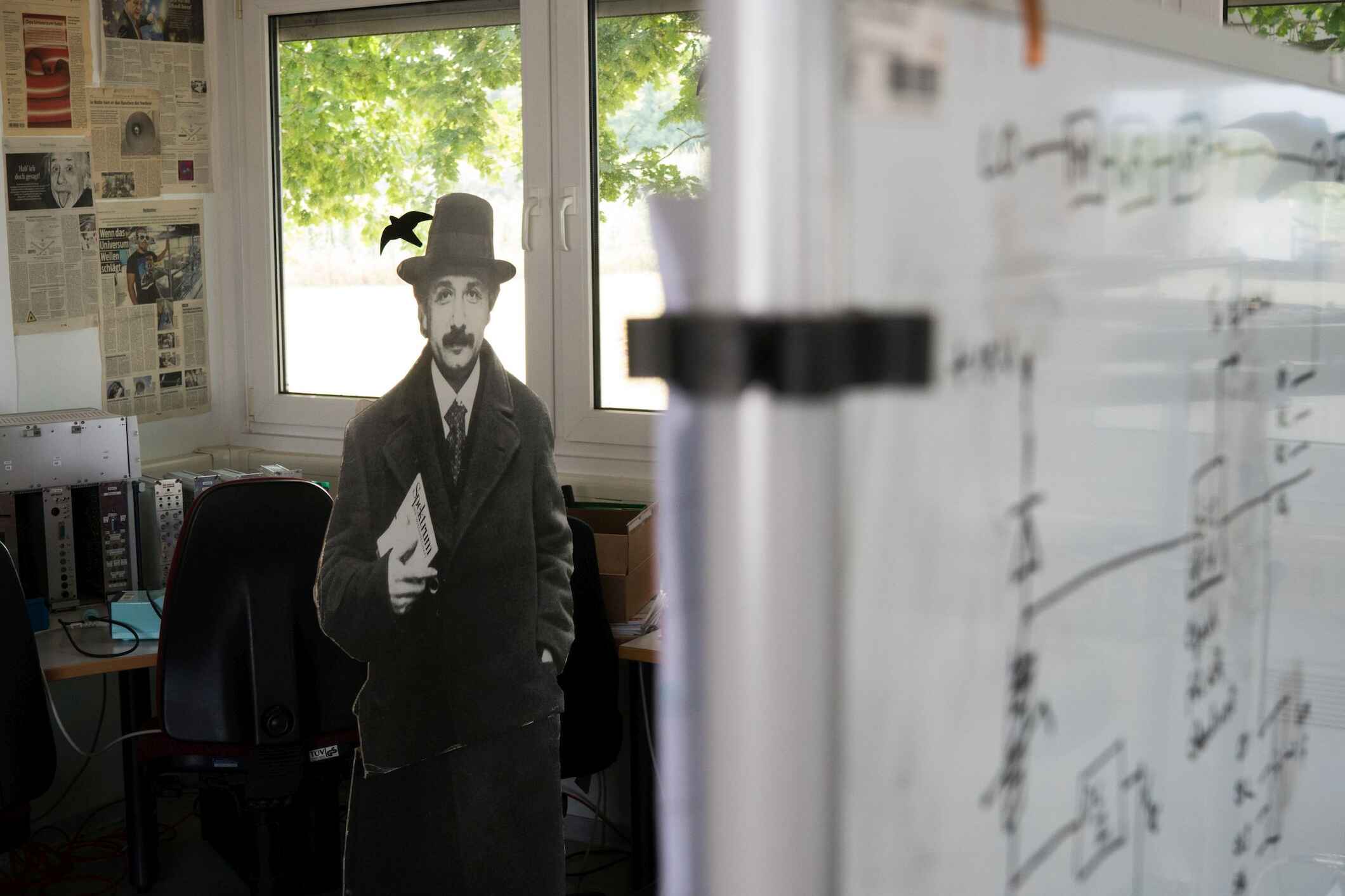
The following illustration may help one imagine the problem posed by noise. If you are sitting in your living room in front of a noisy radio, you would very probably fail to hear the noise of a dripping tap. On the other hand, the noise of toilette that was constantly flushing would be loud enough to make itself heard despite the noisy radio.
With GW150914 the researchers were fortunate that the signal was very strong and thus visible to the unaided eye among the measuring data. Such intensive signals are, however, rather rare. In order to be able to fish out the numerous weaker cosmic messages from the jumble of data in the detectors, the GEO600 scientists employ a type of dragnet. For this purpose a group at the MPI for Gravitational Physics in Potsdam that is specialized in theoretical physics has done computer simulations of the mergers of objects of different masses – from neutron stars to black holes. The database containing these 250,000 fingerprints provides reference samples for comparison, with which it is easier to detect actual collisions in the data streams of the two LIGO detectors. Without these reference samples the less intensive mergers would get lost in the system noise of the detectors.
The three previous LIGO detections confirmed beyond a doubt that there actually are black holes of more than 20 solar masses that originated from supernovae. They also provided the proof that Einstein’s theory of relativity continues to provide correct results, even in extreme situations, such as that of a pair of revolving black holes that just prior to their merger reach a speed just shy of the speed of light.
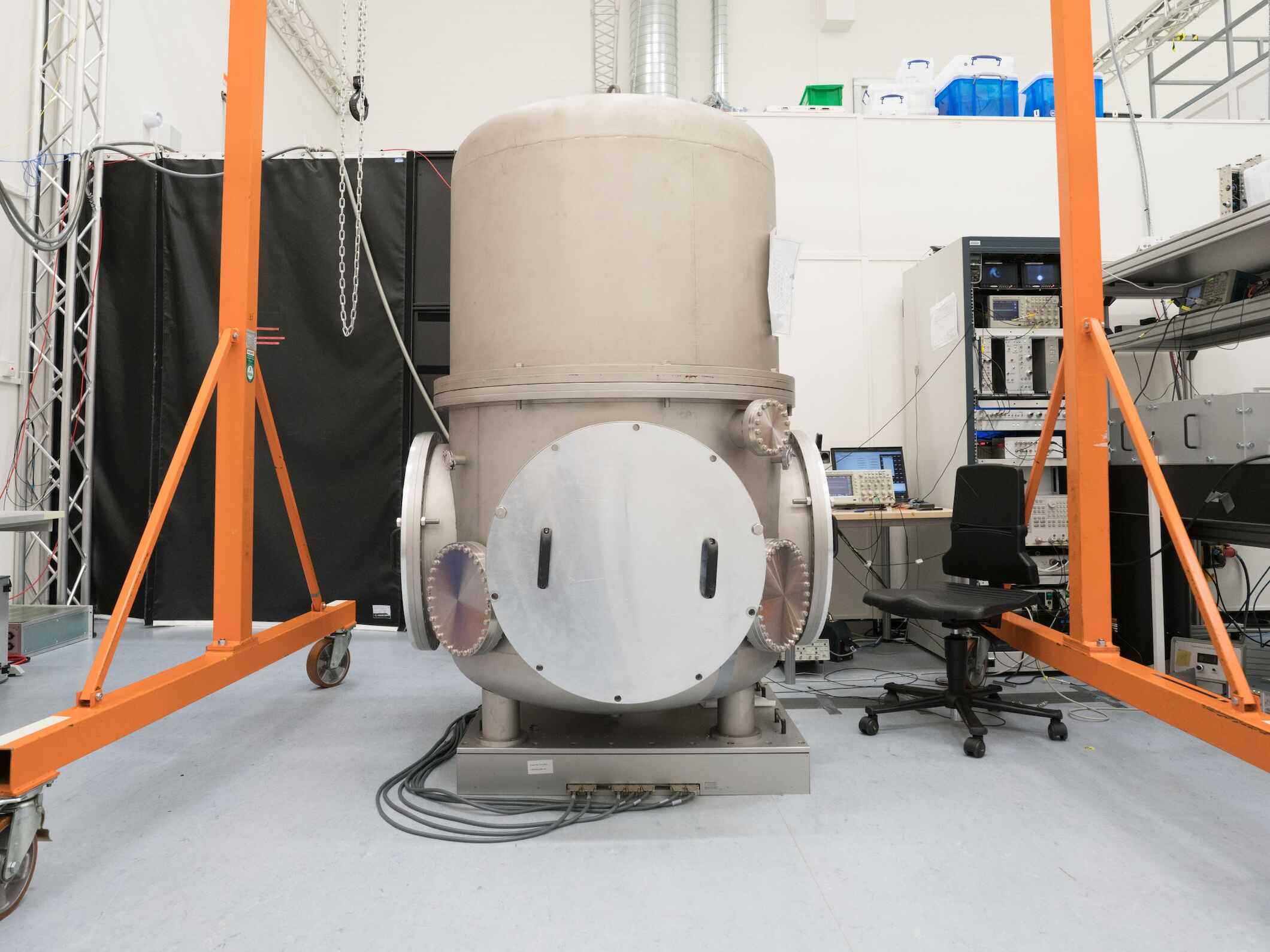
The precision lasers from Danzmann’s team are also suitable for nonastronomical uses. They can, for example, be employed in geodesy (surveys of the Earth) and gravimetry (measurement of gravitational fields). Two GRACE satellites (Gravity Recovery and Climate Experiment) have already been in polar orbit since 2002. They orbit the Earth at a constant distance from one another, which is continuously checked using microwaves. Scientists use the GRACE mission to monitor, among other objects, global climate change. Changes in the Earth’s large-scale groundwater balance and in melting masses of ice, including at the poles and in glaciers, lead to small fluctuations in the Earth’s gravitational field, which are registered by the two satellites. At the beginning of 2018 two new satellites will be launched to take their place (the project GRACE Follow-on). They will measure the distance to one another using a precision laser similar to that in the LISA system, which will improve the precision by a factor of 25.
One of the goals for which Danzmann will utilize the funds accompanying the Körber Prize is to improve the measurement technology even further, such as by increasingly employing quantum entangled photons. “The more precise the perception of our detectors is, the deeper our view into space. I expect that we will soon be able to register new mergers of black holes on a weekly basis and, using future detectors, by the hour. Then we will finally be able to decode the secrets of the dark side of the universe, which accounts for 99 percent of all of its energy. And sometime the gravitational waves will even enable us to hear the echo of the big bang”.
The prizewinner 2017
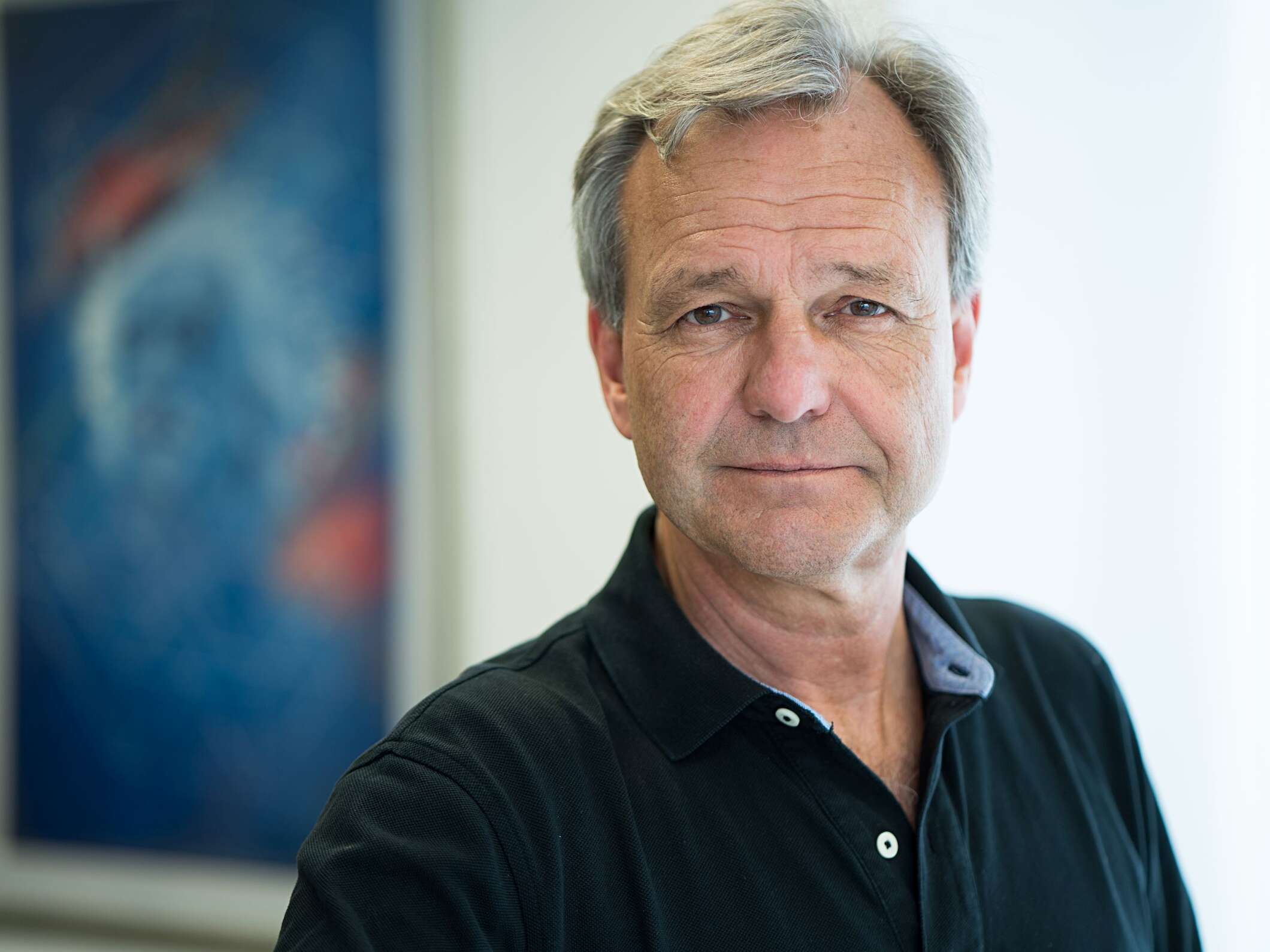
Karsten Danzmann (1955) was born in Rotenburg on the river Wümme in Germany and grew up in Bremerhaven. His mother was a teacher, and his father an engineer.
Unlike other children, the Prize winner never wanted to drive a train but rather to become an astronaut. “I belong to the generation that was decisively molded by the early years of space travel. The early drawings of most children often show flowers or animals or people. On mine there were always rockets and space ships”. As an adolescent, Danzmann had two telescopes: “I spent many nights outdoors in the cold getting numb fingers making observations during the clear winter nights”.
At university, Danzmann turned his childhood dreams into his profession. He studied physics in Clausthal-Zellerfeld and Hannover, where he was awarded his doctorate in 1980. After doing research for several years in Germany, Danzmann left for Stanford University in 1986, where he served as professor of physics until 1989. Starting in 1990, he was a team leader at the Max Planck Institute (MPI) for Quantum Optics in Garching for three years. From 1993 to 2001 Danzmann headed the Hannover branch of the MPI of Quantum Optics. Since 2002, he has been the dire ctor of the MPI for Gravitational Physics in Hannover (the Albert Einstein Institute). Parallel to this, he has served as professor at the Leibniz Universität Hannover, where he has headed the Institute of Gravitational Physics.
It was in particular the period in Stanford that influenced Danzmann’s further development: “not only because the campus is one of the most beautiful in the world, but also because it was there that I learned that our American colleagues were also only mortals and couldn’t walk on water. On the other hand, they think everything is fundamentally possible and try to do it”.
Today, Danzmann is one of the world’s leading experts in the field of gravitational physics. Yet the artistic sides of life are not closed to the Prize winner. In early childhood he learned to play the piano, and he still enjoys playing Chopin and Debussy as well as more modern pieces, such as from musicals. He has also been active in competitive dancing: “Twice I succeeded in winning the second place in the German championship in the under 21 age group”.
Awards Ceremony 2017
Photos of the presentation of the Körber European Science Prize 2017 to Karsten Danzmann in the Hamburg City Hall.
These photos are free to use in the context of news coverage with the credits Körber-Stiftung/ David Aussenhofer given below.
Signals of Gravity from the Depths of Space
